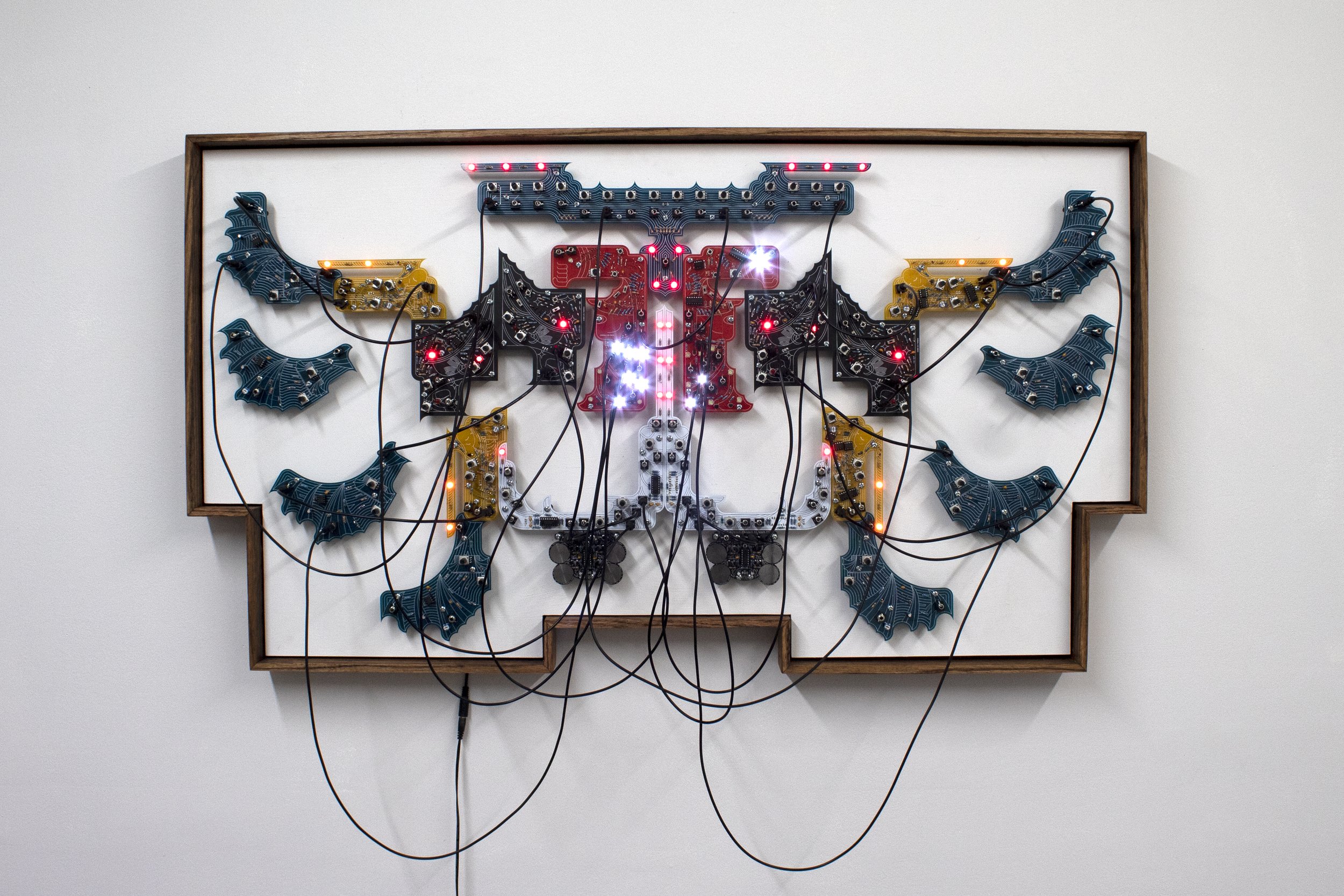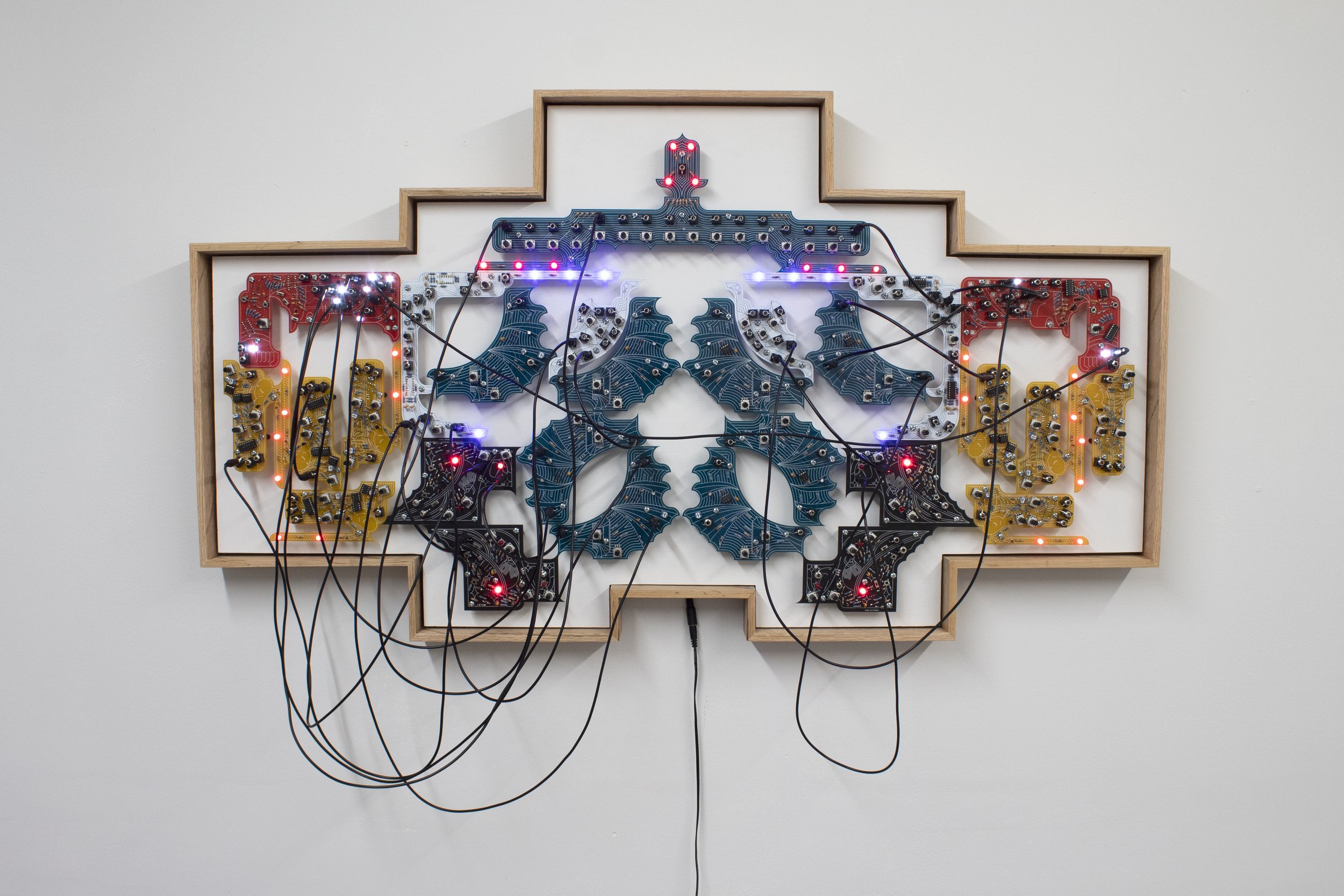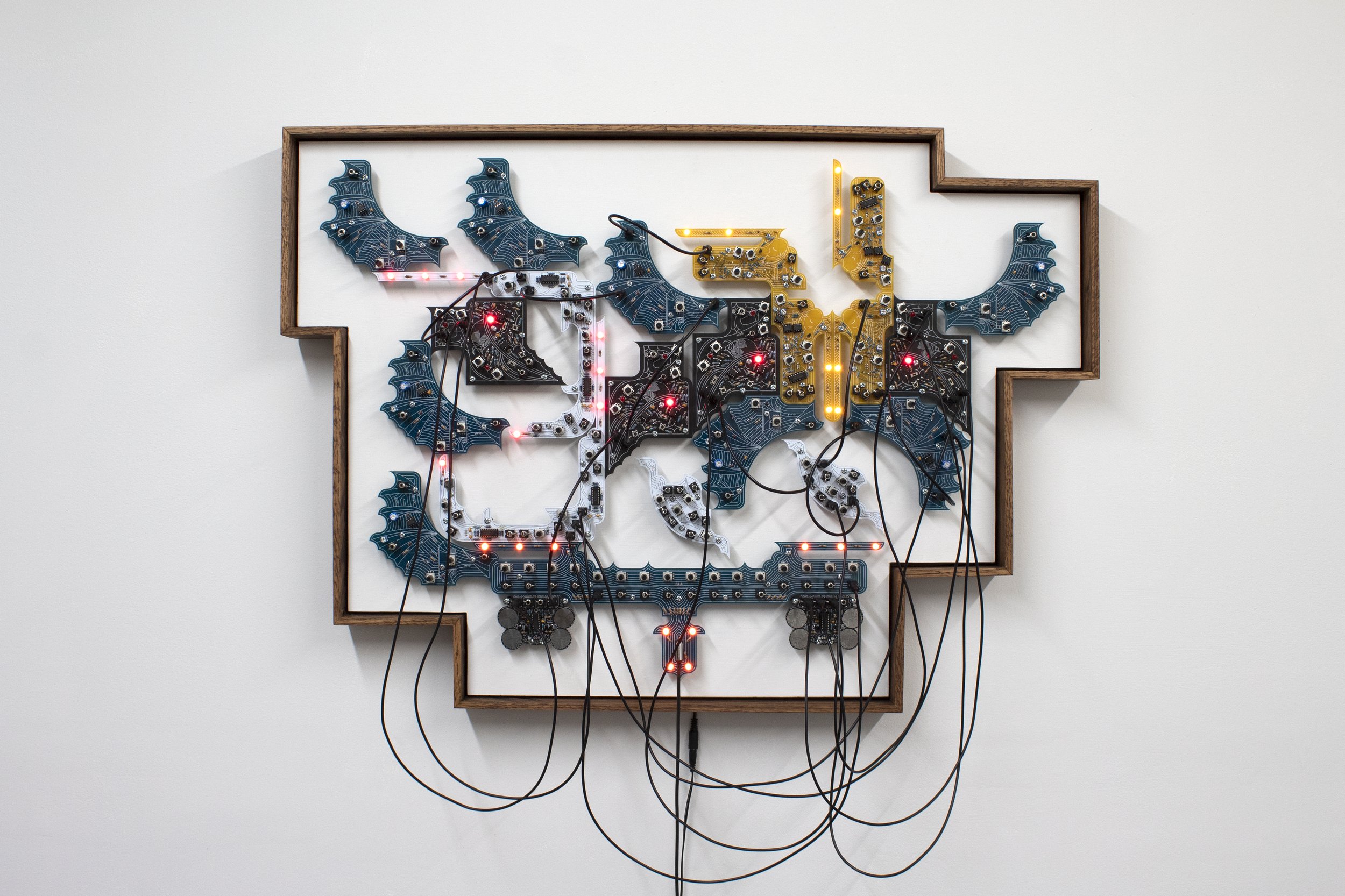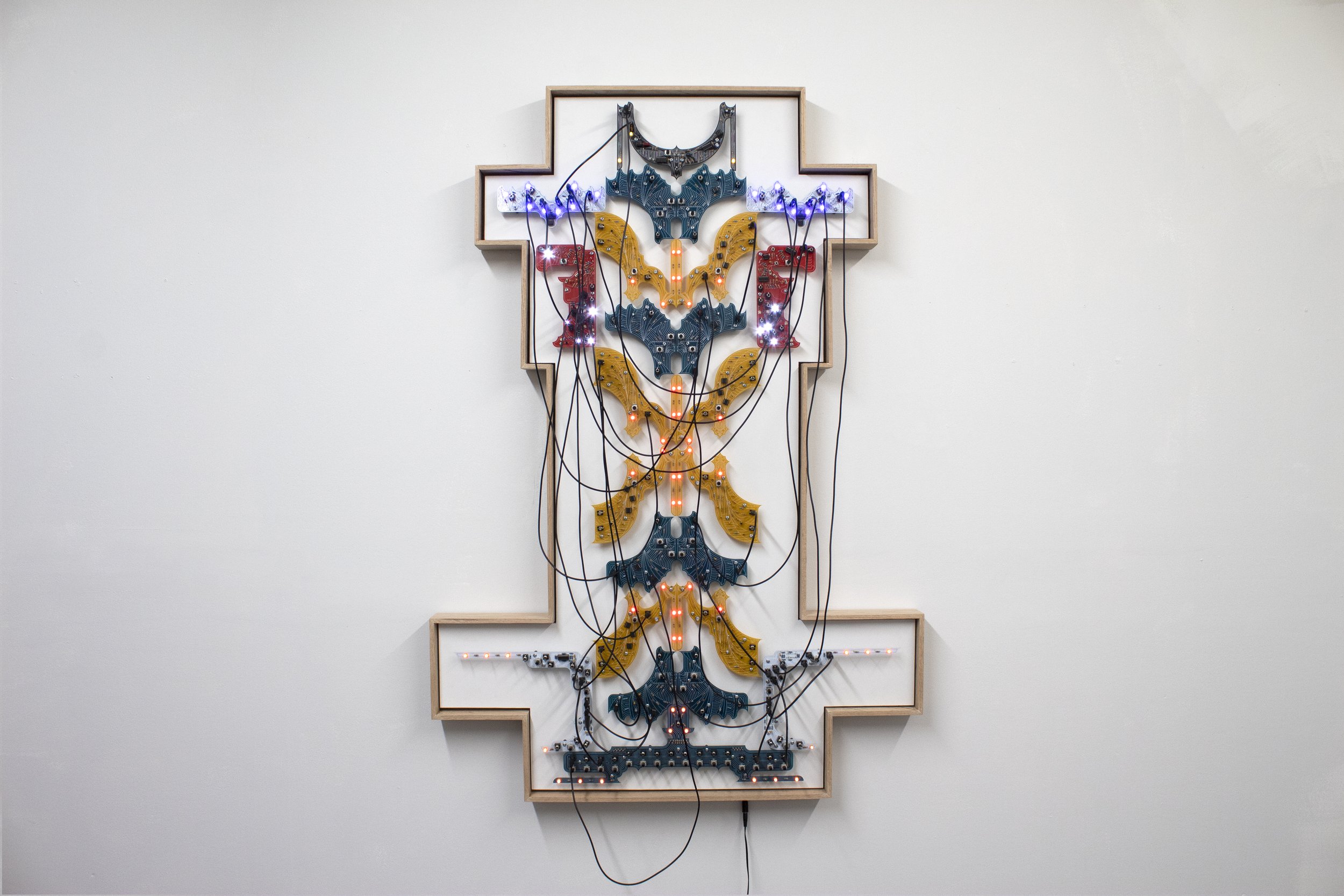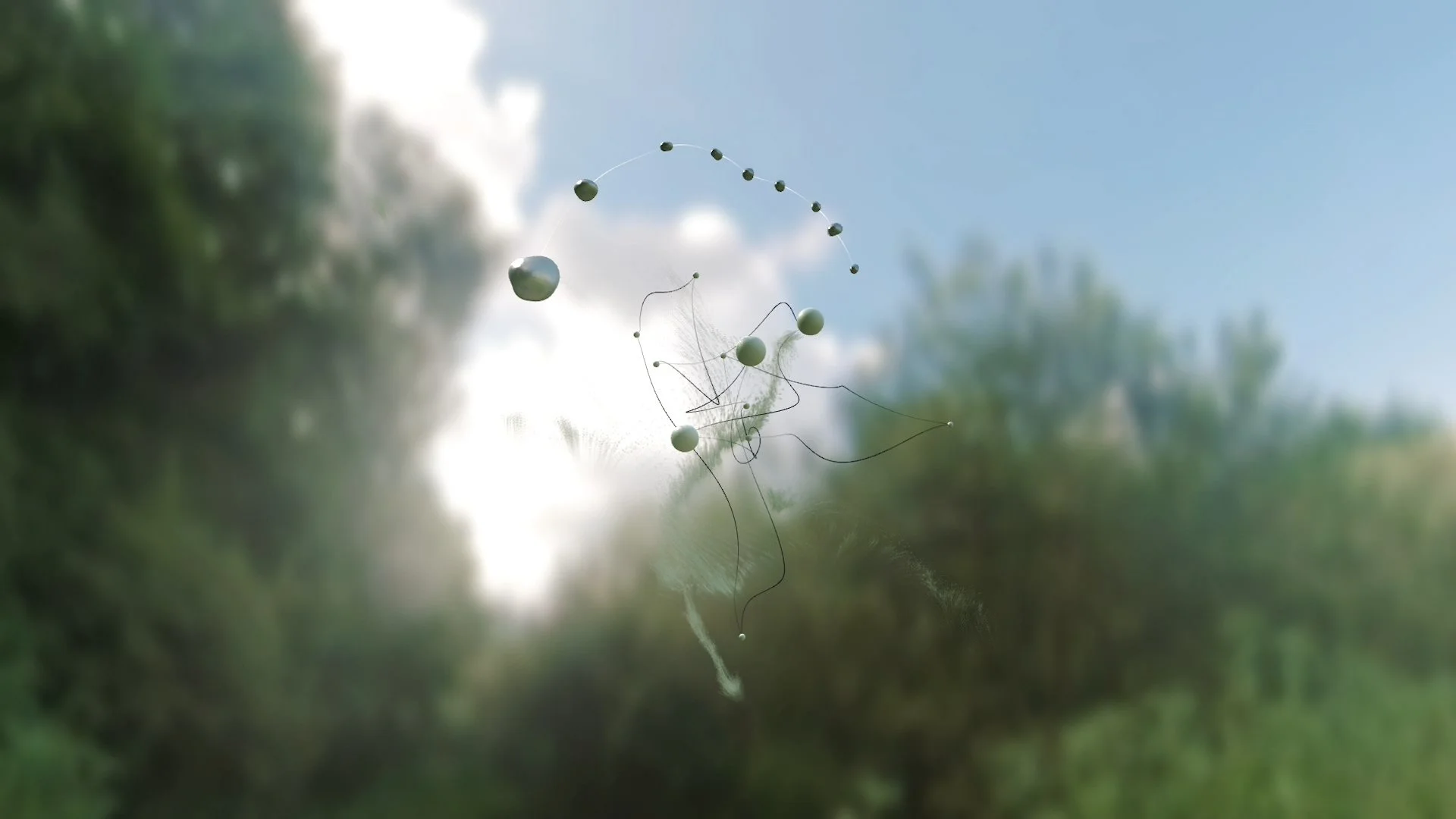Brian Oakes
Interdisciplinary sculptor Brian Oaks magnifies the overlooked hardware in our devices by displaying their artistic potential, as well as technical abilities, on a mass scale. The New York-based artist received his BA in Sculpture, specializing in Computation, from the Rhode Island School of Design in 2018 – kicking off a gracefully evolving and expanding body of work. Exhibited in the U.S., Germany, China, and Japan, Oaks imbeds artistry within every board that he works on – creating pieces that can listen and respond to their environment entirely without the use of software.
A beautiful meditation on humans’ relationship with the device, Oaks’ sculptures combine form and function to allow both his own subconscious to come to life, as well as allowing the machine to stand on its own. Whether they are creating their own ambient drone progressions, or recording and responding to the audio in the room, these works have a presence which cannot be ignored. In a world increasingly more invested in software, his works are a refreshing reminder of the soil which allows a virtual reality to grow, sustained by a community dedicated to the education and development of the technocraft.
Hey Brian! So nice to speak with you! How have you been doing lately?
So nice to talk to you as well! I’ve been good, spending a lot of the last two months preparing for the production year. I like to take time when I can to read and research and plan, and that's mostly what I've been doing since the holidays. Excited to be getting back into the studio.
Excited to see what you get up to! As someone who has only ever worked with circuit boards in middle and high school science classes, I find your works completely ingenious and an amazing development of how art, science, and technology have the capacity to converge – what was it about the medium that first peaked your interest and what made you realize it’s artistic potential?
I started making circuit boards by hand years ago to help control some of the electronics in my early sculptures. I was always interested in using electronics to activate my work and make things that were active in a space (not static). Eventually I felt limited by what kind of circuits I could make by hand. My perfboards were fragile and would constantly break, and the boards I would etch were limited by the sharpies I used to draw the connections. I felt that teaching myself how to make printed circuit boards (PCB’s) would allow me to exceed this limitation and design more complex systems. Once I started getting boards manufactured, I immediately saw potential for them to stand on their own as works of art. The PCB production process has a lot of overlap with printmaking, and the softwares I use to make them can be integrated with softwares like Rhino, Photoshop and Illustrator - all softwares i was already using in my artmaking process. Each new board felt like a blank canvas with so much potential for design intervention.
It seems like a natural evolution of your process, then. Your recent works have such a distinctive style and aura about them – what do you think triggered this shift from more utilitarian pieces (such as Untitled Sound System 2 or Untitled Sound System 10), to sharper, highly stylized pieces we find in your Nocturne No1. exhibition? I feel as though you can see this shift as your work evolved, but what influenced the evolution into this specific style?
I think my first instinct when making these boards was to mount them onto wooden panels and treat them like a painting, as a way to contextualize them as art objects. I really love the work of Peter Vogel who often worked with bare electronics mounted to panels or canvas.
The style of the boards evolved as I understood and became more comfortable with the PCB production process. I have worked with one production house (JLCPCB) in Shenzhen since the beginning and we have a great relationship now. But at first, a lot of my design files were too big for their machines, or would have issues because I didn't really know what I was doing. Coordinating with them, I quickly learned where the limits are and what constraints I would have to work within.
In combination with this development, I was also regularly practicing the surrealist tradition of automatic drawing. In automatic drawing, the hand is allowed to move "randomly" in response to external stimulus (a thought or memory) or material conditions (a dry pen or slick paper). It's a way of applying chance and accident to mark making, but also gives me an opportunity to meditate on a thought or a form - automatic drawing is often framed as a means of expressing the subconscious. I might have a specific function in mind and try to focus on iterating on that, or I might just use it as a way to clear my head and dissociate. After I fill a few pages, I'll scan my sketchbook into Rhino and use the pages as the starting point for my board shapes. For me, this combination of a quick and fleeting gesture matched to a circuit board that goes through an industrial process in a globalized system is a thrilling venture. It is meant to symbolize both an ephemeral promise and a material destiny.
I think that is literally the perfect way to put it – aside from its physical form, I think this also extends to the presence of all of your pieces within a space. Sound is an ever present aspect of your pieces (I love the collaboration piece you made with Bella Carlos) – how do you compare making art with sound, with then creating sound boards and systems which are inherently artistic? How do you feel the two aspects elevate and collaborate within your works?
I love that piece as well. Bella is a dear friend of mine and an incredible artist. It's been great working with them and getting to know their process, as well as finding ways both of our ideas and practices can tie together into a beautiful knot.
When it comes to the use of sound, I like to think of it as a way to activate another part of the work - almost like making a soundtrack. I don't really think of the audio and the visual as caring different weight for these pieces - neither is meant to outshine the rest of the work. They are both meant to contextualize each other. Some works use oscillators and filters and counters to create ambient drone progressions, while other works use microphones and samplers and sequencers to create live-recorded audio compositions that change as the sounds around the work change. Both types of systems utilize electromagnetic noise (think radio static between stations) as an element of chance. In this way, they are meant to give life and motion to the works they are coupled with.
I think this harmony is definitely prevalent and helps to extend your works beyond pieces – more similar to experiences that interact with the space around it. The artwork you create on the circuit boards themselves (as well as so many sick panel designs) puts value and importance on what I feel is probably one of the most overlooked aspects of technology in mainstream societal consciousness – hardware. What does the creative potential of hardware mean to you, and where do you think it fits in a world so increasingly occupied with software?
Great question! Yes it's very strange to me that software has taken such a center stage when it comes to tech innovation. Look at how much apps and phone interfaces have changed design over the last ten years, and yet over the same time the machines they run on look identical (with the exception of an extra camera here and there). I really think the market demand to come out with a new product every year has choked any possibility for exciting hardware design innovation on a mass scale.
I have a real fascination with hardware. The circuits I work with don't use code or microcontrollers like arduinos, teensy’s, PIC’s or raspberry pi’s. I work with what's referred to as “analogue” electronics. This means there's no code or software- the components you see on my boards (the resistors, the capacitors, the transistors, the integrated circuits) are directly shaping the electricity running through them. The component's ability to shape the signal flow is directly dependent on their material makeup (a capacitor made of two different materials can give a different sound output even if they have the same value). I am really captivated with this material relationship. It reminds me of the inherent material relationship of all of technology, something we are becoming more and more aware of as we hear about chip shortages and scarcity playing a role in tech markets.
With everything being on the Cloud, I think it’s so important to actually take a step back and look at the devices through which all of this is possible – your work is undeniably a celebration of that. I’m not sure if you’ve been able to tell, but I did a bit of a cyberstalk and went through your youtube channel. How does it feel to stand in an exhibition space surrounded by your work and spectators, in comparison to uploading something like your Drawbot Demonstration? Were museum spaces a potential you sought for yourself, or more of a natural progression of your work?
It's a really incredible thing to experience, and I feel really lucky that my show at Mery Gates Gallery all came together and that the gallery team believed in my vision and helped me see it realized.
The video you are talking about was one of my first real electronics projects. Everything I did before that was take apart old electronics, try and power them on and then put them back together. I think I built the specific project you're talking about from an article I found in MAKE magazine and filmed it on my dad's little digital camera in 2009 or 2010 – before I was studying art or had a youtube channel or anything. So many of the technical skills I've learned have been through engaging with online communities. I think part of me will always be interested in sharing my technical explorations outside of my art practice with these communities as a way of paying forward the knowledge I've received.
The art school education I received was very heavy to equate the "goal" of an art practice to showing in galleries. And that was definitely my mindset when I began making art. But the PCB works were the first time I stopped thinking about that. This was during the beginning of COVID in New York so galleries were closing, and no one was showing anything anywhere in person. It was nice to let the work be rooted in one material. No matter what I was thinking or trying to express, I knew the output would be a circuit board. And eventually I found my way back to wanting to see this work in front of an audience. How might people react or treat these structures? How would they understand their material makeup? Would they be more interested in the forms or the function?
I definitely hope to be able to see your work in person one day – even observing them virtually has been incredible, and the fact that they carry this history of knowledge that is constantly fed back to the community is, I feel, a vital aspect of using technology to create art. Thank you so much for answering my questions! I’m so intrigued to see what other pieces you come up with in the future. As a final question, are there any dream projects you would want to work on? Regardless of scale, and naturally only if you feel comfortable sharing with us, what is a project that you are eager to create?
I really want to scale up the physical size of the boards and shapes I'm exploring. Right now I'm limited by the production house I work with because their machines have physical limitations. I also really want to start letting other materials into my final piece. I love the idea of “DIY Materialism” where you find ways to make materials from scratch or use materials that only exist as human-made objects (like fordite - a composite of layers and layers of automotive paint build up that can be harvested from the inside of spray booths). I am also hoping to find new ways to intervene in my automatic drawing practice. Maybe changing the scale of how I draw or finding other ways of seeding the forms (maybe by looking through art books or plant taxonomies or something). Thanks so much for your questions! :)
interview ALIA AYOUBI
mastery YANYAN
What to read next











